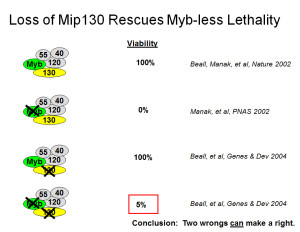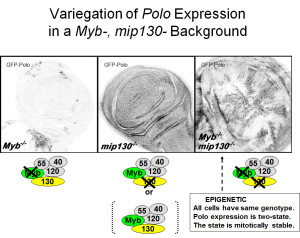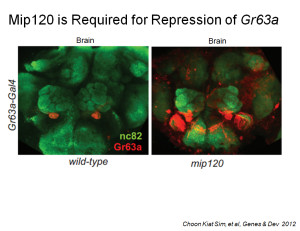In contemporary usage, the word “epigenetic” refers to the inheritance of stable states of gene expression that are not due to differences in the DNA sequence of an organism or its cells. For example, almost all cells in the human body contain the same DNA sequence. However, lung cells divide and give rise to new lung cells, liver cells divide and give rise new liver cells, and so on, even though they all contain the same DNA.
Drosophila that lack a functional Myb gene always die as larvae. However, Drosophila that lack a functional Myb gene and a functional Mip130 gene can sometimes survive to adulthood. Similar “synthetic viability” can occur in Myb, Mip120 double mutants and in Myb, Mip40 double mutants.
The Polo protein is required for proper regulation of several essential processes during mitotic cell division. In the absence of Myb, the expression of Polo is greatly reduced. However, in the absence of both Myb and Mip130 normal levels of Polo expression occur in ~50% of cells in the imaginal wing disc (a larval tissue that will become the adult wing). Cells that express either high or low levels of Polo in a Myb, Mip130 double mutant background are not randomly distributed throughout the tissue. Instead, it appears that the decision to turn Polo “OFF” or “ON” is made early in development and then maintained during subsequent mitotic cell divisions. Such a mottled pattern of gene expression is often referred to as “variegation”. These results imply that the Myb-MuvB/DREAM complex is required for the proper initiation but not for the subsequent maintenance of this epigenetic state.
The function of the Myb-MuvB/DREAM complex is not limited to regulation of the cell division cycle. The ability to accurately detect odors depends on the expression of one and only one odorant receptor in each olfactory neuron. The correct odorant receptor genes must be turned “ON” and all other odorant receptor genes must be turned “OFF”. Analysis of mutant Drosophila in collaboration with the laboratory of Anand Ray (UC Riverside) showed that Myb is required to keep the carbon dioxide receptor “ON” in the correct neurons and other members of the Myb-MuvB/DREAM complex are required to keep the carbon dioxide receptor “OFF” in the wrong neurons. The carbon dioxide receptor is of particular interest because mosquitoes use the homologous receptor to identify humans as a food source.
The images above are of adult Drosophila brains. Neurons expressing Gr63a (red), a subunit of the carbon dioxide receptor, normally project from the olfactory tissue (not shown) to a small region within the antennal lobe of the brain (left panel). In the absence of Mip120, many neurons that project to other areas of the brain abnormally express Gr63a (right panel).


